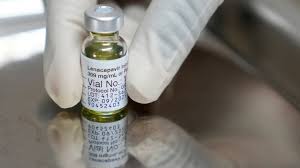Cervical cancer is a significant health issue in Zimbabwe, as stated by Health and Child Care Minister Douglas Mombeshora. The minister emphasized the importance of a sustained f!ght against cervical cancer, which disproportionately affects women and girls in the country.
The statistics provided by Mombeshora are a cause for concern, with cervical cancer being responsible for approximately 2,000 d3aths each year. This highlights the urgency of addressing the issue and implementing effective strategies to reduce the prevalence and mortality rates associated with the disease.
“Cervical cancer remains a concerning public health challenge in our country, as it has far-reaching implications for the health and well-being of our citizens, particularly for our women,” Mombeshora told local journalists and a visiting team from the World Health Organisation (WHO), Geneva, Switzerland.
“The prevalence of cervical cancer in Zimbabwe is worryingly high, with an estimated 3 000 new cases diagnosed each year, out of which an estimated 2 000 women lose their battl3 to this disease,” he added.
“This means that more than 70% of people diagnosed with cervical cancer do not survive.”
The health minister said Zimbabwe is trying hard to combat cervical cancer and has deployed resources to respond to the growing health challenge.
“Today, l want to share a message of determination and hope for Zimbabwe as we proactively take the needed steps to protect our women and conquer this disease in our country.
“Over the past decade, Zimbabwe has been steadfast in its commitment to cervical cancer elimination, and today we reaffirm our dedication to this cause and set our sights on the ambitious goal of eliminating cervical cancer by 2030,” further said Mombeshora.
He underscored that Zimbabwe’s focus against the preventable disease is bold and multifaceted, ensuring equitable access to primary prevention, screening and early detection as well as treatment and care.
Since the inception in 2018 of the national vaccination programme against human papillomavirus (HPV), which is the most common s3xually transmitted infection (STI), remarkable strides have been made in achieving commendable coverage rates, which translate into over two million girls jabbed to date.
HPV vaccines can prevent some of the health effects the virus causes.
“That is why, guided by our national cancer prevention and control plan, we are making critical strides. Over 200 healthcare facilities across Zimbabwe now offer VIAC (Visual Inspection with Acetic Acid and Camera) screenings, and 60 locations provide HPV tests. These expanded services are empowering women with the tools for early detection,” the health minister said.
VIAC is an effective way to prevent cervical cancer in women aged between 30-50 years old. It involves examining the opening of the womb, or the cervix, for changes that might lead to cancer.
Mombeshora, however, lamented that these services have not been able to reach some remote parts of the country.
In a bid to close the gap, government has redoubled efforts to expand access to screening services through targeted outreaches.
Equipping hospitals has also been on top of the agenda, he noted.
“We are stepping up the f!ght by investing in more radiotherapy equipment. This will give women access to the most effective treatments, no matter where they live in Zimbabwe.”
Health education programmes have also been rolled out to raise awareness of the k!ller disease.
“Education of girls to be able to pick signs of cervical cancer have been done. Let us rise to the challenge, united in purpose, to create a future where no woman d!es from cervical cancer. This f!ght we can, and will, win,” said Mombeshora.
The delegation from WHO Geneva, Switzerland later toured Chinhoyi Provincial Hospital where it had an appreciation of a under-equipped laboratory with potential to process samples and produce results locally, thereby cutting the turnaround time.
The WHO entourage, accompanied by the Health minister who is also Mhangura Member of Parliament (MP) and Mashonaland West Provincial Minister Marian Chombo, also visited Umboe Clinic in Mhangura, situated about 40km from Chinhoyi, to have an appreciation of a remote primary health facility.
It was heard during the tour that samples referred to Harare were taking up to six months to be processed and results transmitted back, a development preventing some women to be put on treatment timeously inorder to save lives.
The overlap between HIV and cervical cancer is a defined issue, as mentioned by Prebo Barango, a WHO expert on non-communicable diseases (NCDs) and special initiatives. Efforts to eliminate both diseases have been intensified to address the interconnected challenges they present.
Barango emphasized the importance of collaborations between governments and non-profit organizations in addressing the gaps in resources, such as the lack of staff, consumables, and equipment needed for cancer screening and testing. These partnerships can help ensure that adequate resources are available to combat cervical cancer effectively.
In 2020, the WHO reported that cervical cancer was the leading cause of mortality among women in the African region, with Zimbabwe ranked fourth globally and in the region for its high burden of the disease. This highlights the need for continued efforts to address cervical cancer in Zimbabwe and the importance of early detection, which remains key in eliminating the disease.
SOURCE : NEW ZIMBABWE









